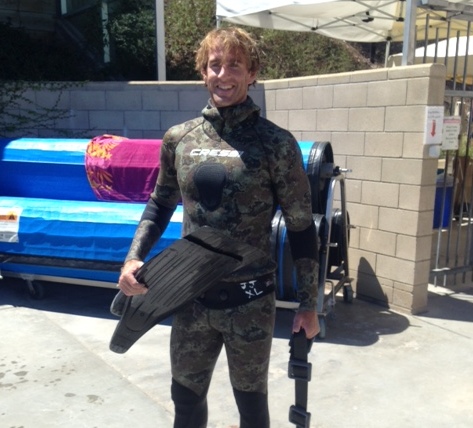Part II of my adventures with free diving – this time in the big Pacific Ocean. If you missed part 1, make sure you check out the post here: Can You Control Your Nervous System With Breathing
12:30pm, La Jolla Shores, San Diego, CA
25 ft. down in the open ocean, I felt my chest compress. I’m staring into my instructor’s eyes as we both descend together along a vertical rope we set up about ¼ mile offshore in the murky waters of San Diego. The beach was closed yesterday due to aggressive hammer head shark activity, but that’s the least of my worries in this current moment.
A blast of cold air shoots across my body. I remember learning in class yesterday of these typical thermocline blasts – deeper cold water mixing with the warmer surface water once you get down past 20 ft.
I’m deeper than I’ve ever been on one single breath.
My body wants air. I tell it in a very nice way, just hold on a sec.
Deeper we go.
30 ft.
The pressure in my chest tightens. I try to equalize my ears (to release the pressure build-up) but I can’t get the release. I try again. No dice.
I feel a vice-like grip clamp down on my head as pressure in my sinuses increase. That’s it. I’ve hit my limit for now.
I turn it around at 30ft and slowly float to the surface.
The plan was to go for 66ft, but I couldn’t get the equalizing down. The pressure in my head was too much and I had to return back up to the surface. You know that feeling when you flying and your ears pop? That’s a change in atmospheric pressure inside your ears.
What happens to the human body as we dive deeper?
Diving to a depth of 33ft actually increases the pressure by 2x the normal amount that we experience at seal level. That pressure in the small cavities of the sinuses must be released through equalizing your ears. You equalize by closing off the airway to your nose and blow air until your feel a little pop. The problem with equalizing while free diving is that you have to do this while holding your breath. If you can’t equalize (which many beginner free-divers have problems with), you run the risk of causing major damage to your sinuses and eardrums.
While I was a little frustrated not getting past 33 ft, I was still happy to go deeper than I had ever been before on a single breath.
All in all, it was a successful dive.
To think after 1 weekend I could go from a 30 second hold to 3 minutes and then dive 30 ft deep in the open ocean felt like a good win.
Many of you guys were asking how I did it and the techniques we used.
In this article, I’ll share the science of breath and how it works to keep us alive, discuss how you can voluntarily affect it, and the specific techniques I used to extend my breath-hold and dive to a depth of 33 ft.
Let’s dive into it, shall we?
How breathing works?
Breathing is one of those rare systems in the body where it’s both voluntary and involuntary. Most functions of the human body – take digestion and blood pressure for example, occur without awareness, and there would be little we could do to really affect these processes.
Breathing is similar in that it’s mostly managed by the subconscious, but it’s also available for control and we can decide at any moment to consciously change the way we breath. Since we are breathing all the time, this duality seems strange.
But we can affect the way our body behaves by simple changing the way we breath. You can change your own physiology right this second by consciously focusing on your breathing.
Want to calm down and slow your heart rate, take deep slow inhalations with a slightly longer exhalation. This type of restorative breath will slow everything down and consume much less oxygen.
Alternatively, if you want to get jacked up a bit, take short shallow inhales with vigorous exhales, sort of like you’re hyperventilating. This will increase heart rate and blood pressure and require lots of oxygen.
Why do we need to breathe?
We breathe to supply oxygen to the cells of the body for energy. Without oxygen, cells die. When cells die, especially in the vital organs, we die. Oxygen is what keeps us alive. And when we exhale, we get rid of carbon dioxide (C02), a waste product produced by energy production in the cells.
It’s simple enough – we inhale to get oxygen to fuel cells, we exhale to get rid of a waste product (CO2).
Now, when you hold your breath for an extended period of time, the CO2 starts to build in your bloodstream. It becomes very uncomfortable and it’s the major obstacle to holding your breath for a long period of time. Training your body to get comfortable with this uncomfortable sensation is the key.
Quick Summary: breath holding comes down to the following factors:
- How calm you can be (lower heart rate = less oxygen used)
- Getting rid of any excess CO2 prior to taking your big inhale
So, with that knowledge in hand, here’s the step-by-step instructions to lower your heart rate and clear your body of excess CO2.
Check out the video below.
Step 1
Get as relaxed as possible to decrease your heart rate. The single biggest factor in breath holding is the ability to calm down and settle your heart rate. You accomplish this by deep belly breathing.
Deep belly breathing
This style of breathing requires you to use the big diaphragm muscle that sits just above your stomach. I’ve written before about how belly breathing can help reduce stress. Belly breathing achieves this goal by allowing you to access the parasympathetic nervous system. This is the “rest and digest” part of your nervous system that’s in direct contrast to the sympathetic system, the one responsible for “fight or flight” that we’re all aware of.
Unfortunately, most of are running around in this sympathetic state which uses more of the chest and rib muscles to breath. Learning to access the diaphragm with belly breathing might be challenging for some of you, but with a little practice, you can easily do it.
Objective of belling breathing:
- reduce heart rate
- help turn down stress hormones
- more oxygen to muscles
How to do it: Lie in a comfortable position with one hand on your chest and the other on your stomach. As you take a big inhale, try to lift the hand that’s on your stomach while keeping your chest quiet.
Once you have the technique down, focus on inhaling for 2 seconds and exhaling for 10 seconds. Repeat this cycle for 2 minutes.
Step 2
After the 2 minutes of belly breathing, perform 5 rounds of purging breaths.
Purging Breaths
This type of breathing requires you to use the lungs to forcefully expel air out.
Objective of purging breaths:
- Clear excess C02 from the body
How to do it: Inhale for 2 seconds, pause for 1 second, and exhale for 5 seconds intently trying to blow out a candle about 4 ft. in front of your mouth.
This will clear more C02 out of your blood, and you’ll be able to hold your breath longer.
Step 3
After 5 rounds of purging breaths, return to normal breathing for 10 seconds.
Remain as calm as possible without any movement. Any movement will cause an increase in heart rate and more oxygen demand from the body. This will rob your precious oxygen.
Step 4
Take a large breath by starting in your belly, then fill up your chest, and lastly get a little more air from your neck.
Have your buddy start the timer and off you go.
How’d you do? I want to hear about it!
Have a great day.
Nick





